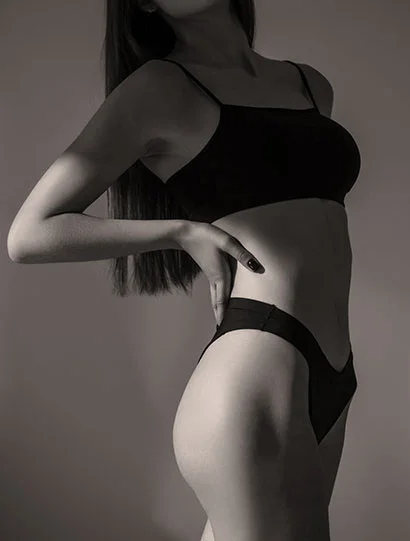Liposuction
If you are struggling with troublesome pockets of excess fat that don’t respond to diet and exercise, liposuction can help you achieve a smoother and more toned appearance. Dr. Berry Fairchild, a Houston body contouring specialist, offers a range of liposuction techniques and designs customized treatment plans for each patient with a focus on delivering exceptional aesthetic outcomes.
What Is Liposuction?
Liposuction, also called lipoplasty, is a surgical procedure that removes excess fat from various areas of the body by using suction techniques. It is designed to help sculpt the body and produce a slimmer and more toned appearance. Liposuction is typically performed on the abdomen, hips, thighs, arms, and neck, and is not a weight loss solution, but rather a way to reshape specific areas of the
Trusted Source
Liposuction
Cleveland Clinic
Go to Source
body.
Types of Liposuction Techniques
There are several different types of liposuction procedures available because each technique has its own advantages and disadvantages, and may be better suited for certain areas of the body or specific goals. The different liposuction techniques also vary in terms of invasiveness, precision, and recovery time. Each of these techniques has its own unique benefits for specific areas of the body, and board-certified plastic surgeon Dr. Fairchild will determine the best type of liposuction for you based on your specific anatomical needs and cosmetic goals.


Traditional Liposuction
Traditional liposuction, also known as suction-assisted liposuction (SAL), is a surgical procedure that removes excess fat from the body. During traditional liposuction, the surgeon makes small incisions in the skin and inserts a cannula, a thin, hollow tube, into the fatty tissue. The cannula is attached to a suction device that helps to remove the excess fat from the body.
Tumescent Liposuction
Tumescent liposuction is a type of liposuction that uses a large volume of a solution known as tumescent fluid to help reduce the amount of bleeding and swelling during the procedure. The tumescent fluid is made up of a mixture of saline solution, a local anesthetic (lidocaine), and an adrenaline-like substance called epinephrine that helps to shrink blood vessels and reduce bleeding.
Laser-Assisted Liposuction
Laser-assisted liposuction, also known as laser lipolysis or Smartlipo, is a type of liposuction that uses a laser to melt and remove excess fat from the body. The laser energy used in laser-assisted liposuction is delivered through a small, fiber-optic laser probe that is inserted into the fatty tissue through small incisions.
Power-Assisted Liposuction
Power-assisted liposuction (PAL) is a type of liposuction that uses a specialized cannula that oscillates back and forth at high frequencies to break up and suction out excess fat. The oscillating motion of the cannula is powered by a small motor attached to the device and allows Dr. Fairchild to remove more fat with less effort and discomfort.
Ultrasound-assisted Liposuction
Ultrasound-assisted liposuction (UAL) is a type of liposuction procedure that uses ultrasound energy to break up and liquefy fat before it is suctioned from the body. During UAL, Dr. Fairchild inserts a cannula equipped with an ultrasound probe into the fatty tissue. The ultrasound energy emitted from the probe helps to break up and loosen the fat, making it easier to remove.
What Areas Can Liposuction Treat?
Liposuction can treat a variety of areas on the body where excess fat is stored, including:
- Abdomen
- Hips
- Thighs
- Upper Arms
- Back
- Breasts (gynecomastia surgery)
- Buttocks
- Chin and neck
- Calves and ankles
It is important to note that the liposuction body contouring procedure is not a substitute for weight loss, but rather a way to reshape specific areas of the body that have not responded to diet and exercise.
Candidates For Liposuction
The best candidates for liposuction are individuals who are non-smokers and in good overall health, and have realistic expectations about the results of the procedure. These individuals are at or close to their ideal body weight with pockets of excess body fat that they would like to remove, and have good skin
Trusted Source
Liposuction Candidates
ASPS
Go to Source
elasticity.
This cosmetic surgery should not be used to treat obesity or as a means of weight loss.
Individuals with medical conditions such as heart disease, diabetes, or a weakened immune system may not be suitable candidates for the procedure. During your consultation, Dr. Fairchild will perform a thorough examination, review your medical history and your cosmetic goals, and will be able to determine if you are a good candidate for liposuction surgery.
The Liposuction Procedure
Liposuction is typically performed as an outpatient procedure under local anesthesia with sedation or general anesthesia. The specific details of the procedure can vary depending on the size and location of the fat deposits, however, the liposuction procedures typically begin with Dr. Fairchild making small incisions in the target area, through which a cannula (a thin, hollow tube) will be inserted to suction out the fat cells. Dr. Fairchild will then use the cannula to loosen and suction out the excess fat. This is usually done using a controlled back-and-forth motion, and the fat is suctioned out through a vacuum-like device.
Liposuction Recovery
Recovery after liposuction typically involves some discomfort, swelling, and bruising in the treated area. The extent of these symptoms can vary depending on the size of the treatment area and the individual’s own healing process.
During the recovery period, you can expect to wear a compression garment to help reduce swelling and promote healing. Some discomfort is normal and Dr. Fairchild will help you manage it with pain medication. Dr. Fairchild also recommends a series of lymphatic drainage massage following body contouring procedures. You will be advised to avoid strenuous physical activity for a few days to a week after the procedure to allow time for the incisions to heal. The full results of your liposuction procedure will become apparent after several weeks to a few months as the swelling and bruising subside. It is important to keep in mind that everyone’s recovery process is different and to follow the specific instructions provided by Dr. Fairchild to ensure an optimal recovery.

FAQs About Liposuction
Is liposuction safe?
Liposuction is a safe and effective procedure when performed by a qualified plastic surgeon or specialist. As with any surgery, there are risks and potential complications that Dr. Fairchild will discuss in depth with you prior to the procedure. These
Trusted Source
Liposuction Risks and Safety
ASPS
Go to Source
risks
include anesthesia risks, bleeding, blood clots, infection, numbness and tingling, scarring, asymmetry, and contour irregularities.
Is liposuction painful?
Liposuction is typically performed under either local or general anesthesia, so the patient should not feel any pain during the procedure. After the procedure, some discomfort, swelling, and bruising can be expected, but these symptoms can be managed with pain medication.
How much weight can I expect to lose with liposuction?
Liposuction is not a weight loss procedure, and the amount of fat that can be removed with liposuction is usually limited to a few pounds. The goal of liposuction is to remove pockets of excess fat and improve the shape and contour of specific areas of the body, not to achieve significant weight loss.
How long does liposuction take?
The length of a liposuction procedure can vary depending on the size and location of the fat deposits, as well as the surgeon’s preference and experience. On average, a liposuction procedure can take anywhere from one to several hours.
What is the recovery time for liposuction?
Most patients are able to return to work and normal activities within a few days to a week after a liposuction procedure. However, the extent of the recovery period can vary depending on the size of the treatment area and the individual’s own healing process.
Are the results of liposuction permanent?
The results of liposuction are generally long-lasting, but they can be affected by significant weight gain or loss, aging, and other factors. Maintaining a healthy lifestyle, including a balanced diet and regular exercise, can help to preserve the results of the procedure.
What is the cost of liposuction?
Liposuction can vary in cost depending on various factors such as the location of the procedure, the type of liposuction being performed, and the size of the treatment area, as well as if any other procedures are performed concurrently.
Can liposuction get rid of cellulite?
Liposuction can help to remove excess fat from the body, but it is not specifically designed to treat cellulite or
Trusted Source
Liposuction
Mayo Clinic
Go to Source
dimpling.
Cellulite is a condition that causes the skin to have a dimpled, lumpy appearance, often found on the hips, thighs, and buttocks. While cosmetic procedures like liposuction can help to smooth out some of the bulges and bumps caused by excess fat, they may not have a significant impact on the appearance of cellulite.